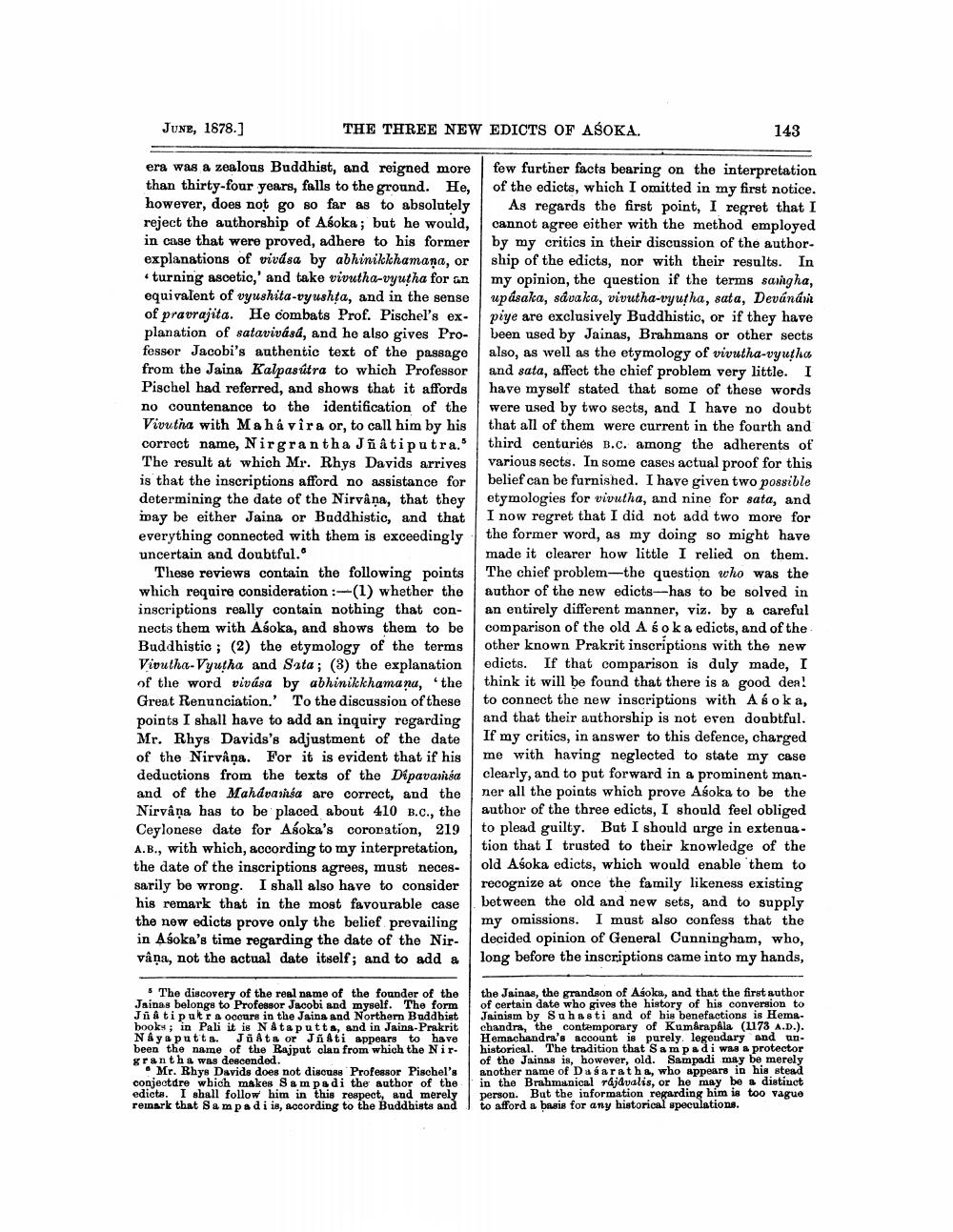________________
THE THREE NEW EDICTS OF ASOKA.
JUNE, 1878.]
era was a zealous Buddhist, and reigned more than thirty-four years, falls to the ground. He, however, does not go so far as to absolutely reject the authorship of Aśoka; but he would, in case that were proved, adhere to his former explanations of vivása by abhinikkhamana, or turning ascetic,' and take vivutha-vyutha for an equivalent of vyushita-vyushta, and in the sense of pravrajita. He combats Prof. Pischel's explanation of satavivásá, and he also gives Professor Jacobi's authentic text of the passage from the Jaina Kalpasútra to which Professor Pischel had referred, and shows that it affords no countenance to the identification of the Vivutha with Mahavira or, to call him by his correct name, Nirgrantha Jñâtiputra. The result at which Mr. Rhys Davids arrives is that the inscriptions afford no assistance for determining the date of the Nirvâna, that they may be either Jaina or Buddhistic, and that everything connected with them is exceedingly uncertain and doubtful."
These reviews contain the following points which require consideration :-(1) whether the inscriptions really contain nothing that connects them with Aśoka, and shows them to be Buddhistic; (2) the etymology of the terms Vivutha-Vyutha and Sata; (3) the explanation of the word vivása by abhinikkhamana, 'the Great Renunciation.' To the discussion of these points I shall have to add an inquiry regarding Mr. Rhys Davids's adjustment of the date of the Nirvana. For it is evident that if his deductions from the texts of the Dipavamsa and of the Mahávamsa are correct, and the Nirvana has to be placed about 410 B.C., the Ceylonese date for Aśoka's coronation, 219 A.B., with which, according to my interpretation, the date of the inscriptions agrees, must necessarily be wrong. I shall also have to consider his remark that in the most favourable case the new edicts prove only the belief prevailing in Aśoka's time regarding the date of the Nirvâna, not the actual date itself; and to add a
The discovery of the real name of the founder of the Jainas belongs to Professor Jacobi and myself. The form Juâ tiputra occurs in the Jaina and Northern Buddhist books; in Pali it is Nataputts, and in Jaina-Prakrit Nayaputta. Jäta or Jñati appears to have been the name of the Rajput clan from which the Nirgrantha was descended.
Mr. Rhys Davids does not discuss Professor Pischel's conjecture which makes Sampadi the author of the edicts. I shall follow him in this respect, and merely remark that Sa mpadi is, according to the Buddhists and
143
few further facts bearing on the interpretation of the edicts, which I omitted in my first notice.
As regards the first point, I regret that I cannot agree either with the method employed by my critics in their discussion of the authorship of the edicts, nor with their results. In my opinion, the question if the terms saigha, upasaka, sávaka, vivutha-vyutha, sata, Devánám piye are exclusively Buddhistic, or if they have been used by Jainas, Brahmans or other sects also, as well as the etymology of vivutha-vyutha and sata, affect the chief problem very little. I have myself stated that some of these words were used by two sects, and I have no doubt that all of them were current in the fourth and third centuries B.C. among the adherents of various sects. In some cases actual proof for this belief can be furnished. I have given two possible etymologies for vivutha, and nine for sata, and I now regret that I did not add two more for the former word, as my doing so might have made it clearer how little I relied on them. The chief problem-the question who was the author of the new edicts-has to be solved in an entirely different manner, viz. by a careful comparison of the old A sok a edicts, and of the other known Prakrit inscriptions with the new edicts. If that comparison is duly made, I think it will be found that there is a good dea! to connect the new inscriptions with Aśoka, and that their authorship is not even doubtful. If my critics, in answer to this defence, charged me with having neglected to state my case clearly, and to put forward in a prominent manner all the points which prove Aśoka to be the author of the three edicts, I should feel obliged to plead guilty. But I should urge in extenuation that I trusted to their knowledge of the old Aśoka edicts, which would enable them to recognize at once the family likeness existing between the old and new sets, and to supply my omissions. I must also confess that the decided opinion of General Cunningham, who, long before the inscriptions came into my hands,
the Jainas, the grandson of Asoka, and that the first author of certain date who gives the history of his conversion to Jainism by Suhasti and of his benefactions is Hemachandra, the contemporary of Kumarapala (1173 A.D.). Hemachandra's account is purely. legendary and unhistorical. The tradition that Sampadi was a protector of the Jainas is, however, old. Sampadi may be merely another name of Dasaratha, who appears in his stead in the Brahmanical rájávalis, or he may be a distinct person. But the information regarding him is too vague to afford a basis for any historical speculations.




